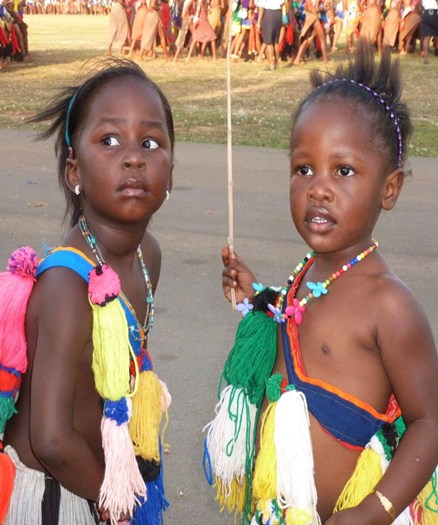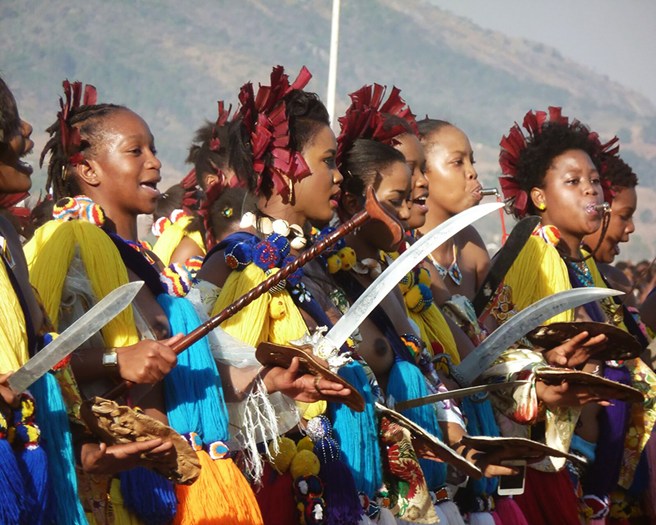AFRICA - Swaziland was not on my bucket list. I didn’t even know where it was when I first heard about a volunteer position with the Swaziland Action Group Against Abuse. But, during my stint as communications officer with the organization, my eyes were opened to the jaw-dropping beauty of this tiny kingdom of 1.2 million, tucked between Mozambique and South Africa.
Work was tough, but on weekends I was revitalized, exploring the countryside and taking in local culture with new friends – mostly international expat volunteers like myself.
I found the country’s game parks to be most fascinating and Mlilwane Wildlife Sanctuary was where I had my first encounter with Swazi critters.
Camille (from Montreal), Hayley (from London) and I wandered the peaceful nature trails, strolling with antelope and zebras and keeping our distance from a very large crocodile sunning himself by the lake. On our way to the Hippo Haunt, the sanctuary’s cozy restaurant, we spied another big fella. This guy was wandering around the campfire area, very subdued, his back covered in angry red scratches.
“He got in a fight with another hippo,” a ranger explained. He told us hippos are territorial and are known to charge and trample people, so we gave him a wide berth and hurried into the restaurant.
Hlane Royal National Park was the only Swazi park with lions. On another weekend trek I got up before sunrise to track the majestic beasts.
The early wakeup call paid off and I was thrilled when our safari group glimpsed a pride of amber royalty. To top it off, when I was waiting for sunset at the watering hole, a mama white rhino and her baby came down for a drink.

Above: The herd of rhinos gathers at a local watering hole.
At Mbuluzi Game Reservem giraffes were the highlight, as well as swimming in the frothy Mbuluzi River.
“Crocs don’t like fast moving water,” our guide told us. Whew!
You do some adventurous things when you’re in places like Swaziland — I had never whitewater rafted before, so I took the plunge (literally) and joined a group going to the Great Usuthu River.
We were two per raft and my stomach flipped as we paddled towards a churning wall of water. My rafting partner Isabel, a fearless Aussie, and I were quickly dunked. Thankfully we had on life jackets and helmets and our guides helped us retrieve the runaway raft.
My next challenge was scaling Sibebe Rock. Three billion years old and 350 metres high, the rock, or pluton, is a formation somewhat like Australia’s Uluru (Ayers) Rock. Instead of clambering straight up (a tad dangerous), I chose the gentle ascent, a roundabout trail through tall grasses that took me around two hours.
Enough of this outdoor adventure stuff — let’s party!
The biggest annual celebration in Swaziland is Umhlanga, also known as the Reed Dance. In late August, young women spend eight days chopping down reeds and presenting them as windbreaks for the Queen Mother’s residence.
At the ceremony’s finale, Camille, Isabel, Hayley and I watched as 10,000 “maidens” (young, unmarried, childless) danced in front of the Queen Mother and her son, King Mswati III.
They were magnificent dancing in their brightly coloured sashes over bare breasts and the smallest of skirts. At one point the king, dressed in leopard skin, came down from his viewing platform and greeted some of the maidens.
“He sometimes picks a wife at the Reed Dance,” my Swazi friend Tenele explained later. She also told me he has 15 wives while his father, King Sobhuza II, had 70.


Above: Local women, young and old, entertain the tourists.
The colourful festival and participants inspired me to acquaint myself with village life in Swaziland, so one Sunday I joined some friends and took a tour of Lobamba, the traditional, spiritual and legislative capital city of Swaziland.
Our guide Beki led us down leafy streets lined with mud houses to a small courtyard filled with low benches.
“Are you thirsty?” he asked.
We nodded and a woman brought us a large pickle jar filled with what looked like grey dish water.
“Sorghum beer,” explained Beki, taking a swig.
I took a small sip from the communal jar and made a face. It was sour and unappealing. Beki could tell we were not impressed. He disappeared into the hut and came out with a clay bowl filled with thick white liquid.
“Maize drink, non-fermented,” he explained.
It was cool, sweet and delicious and we gave him the thumbs up.
At the Stick and Mud Gallery we met a small man with dreadlocks and a bright smile. “Welcome, come into my home and studio,” said Lucky Mlotsa expansively.
The walls were covered with his art, colourful paintings of Swazi life.
“I’ve been teaching community members to paint. Four of my students won national competitions. That’s when I started taking myself seriously,” he explained proudly.
Lunch was at a local butchery. After picking out some chicken, we placed it on a smouldering grill. Along with the chicken, we devoured mouth-watering plates of coleslaw, boiled pumpkin leaves, tomato-avocado salad and pap (made from cornmeal). All eaten with our hands. Thankfully, I was equipped with Wet Ones.
When it came to buying mementoes of my trip to Swaziland, I wanted to make sure I purchased “fair trade souvenirs.”
Since Camille was volunteering for a local organization called Gone Rural, which promotes such purchasing, one Saturday I went out to see her at the shop in the community of Malkerns.
She told me the boutique, which specializes in woven items made from plant materials, was supplied by 800 rural women who worked from their homes and received 40 per cent of the wholesale price.
My eyes widened as I took in the rainbow array of placemats, baskets, and rugs. I learned that Gone Rural exports its products around the world, including to 10,000 Villages outlets in Canada.
Wanting to buy straight from the source, I chose a handful of stackable baskets as gifts for friends at home.
Tiny Swaziland has some big problems – high rates of HIV/AIDS, domestic violence and little employment. As volunteers with development organizations we were all there to help. And yet, the country’s beauty and the friendliness of the people are unmatched. I will be forever grateful for those amazing weekends.